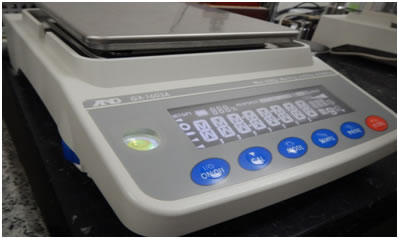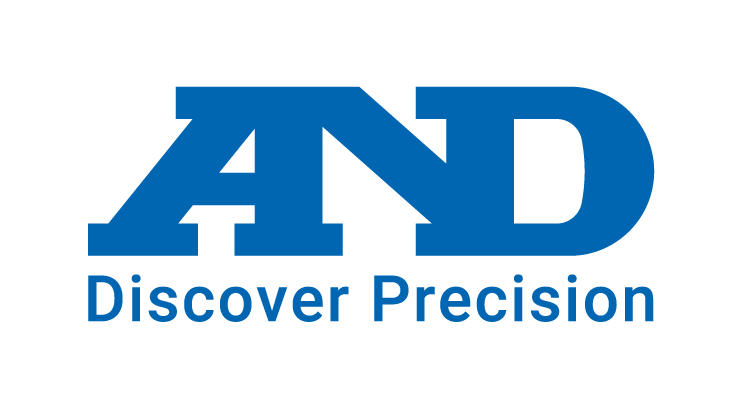For this installment of the developement series I would like to share some details on the ongoing development of the successor models to the GX/GF Series of Precision Balances released 15 years ago.
These top loader balances have the mass sensor mechanisms and the circuit board housed inside a case with the weighing pan placed on top as the name suggest. The minimum weighing displays are 1mg, 10mg, and 0.1g and the weighing range is between 200 grams and a few kilograms. The ratio of the minimum display to the capacity is approximately 100,000~1,000,000 to 1. These balances are capable of high resolutions and sensitivities and as such make up a key market area for weighing instrument commodities and are used in a wide range of applications from the inspection and quality control of parts on a production line for industrial products to experiments and research at universities. Also the exceptional cost performance and user-friendliness of these balances make them ubiquitous in biological and medical research as well as food and materials development laboratories.
I have mentioned before that in the year 2000 when the original GX/GF was developed, three or four competitors had already proposed new “mono” (single unit) structure mass sensors. However, to me following this idea would only entail playing catch up to other companies. Moreover using a specialized “mono” structure would limit the processing methods, requiring capital and investment in production facilities. The large initial investment was a cause for worry that led us to conceive the super hybrid sensor (SHS) with a method of combining modular high precision parts instead of having a “mono” structure. I have written previously about the research leading up to our unique hybridization and realization of the actual sensor.
When we were developing the SHS, Japan was at a high level of technological sophistication and fortunately we had maintained long-standing cooperative relationships with manufacturers of high quality parts. They boldly set out on the machining process of the Roverbal structure, which was the key component of the SHS that we planned. This would result in the production of specialized components being done with general processing machinery turning the hybrid structure into reality. Some time has passed since the development of the original SHS and even now, the GX/GF series equipped with the first SHS remains securely as the leading balance in Japan. At the same time the SHS has evolved and is currently finding uses in devices from microbalances to industrial balances and sensors for moisture analyzers.
When the SHS was being developed, our competitors were focused on mono structure designs so proposing a hybrid structure was met with significant criticism from within A&D, with people suggesting it was a hopeless endeavor. However, to use an example from the automotive industry, most customers don’t really care whether the camshafts of a car are SOHC or DOHC, or if it is a turbocharger or supercharger, or if it’s a diesel or hybrid vehicle. What people actually care about is the comfort when driving (acceleration, stability, collision safety, space, storage, convenience) and fuel efficiency, and whether they are commensurate with the initial investment and required maintenance fees. In other words, the materials that are advertised as relevant to cars are only means, not the ends..
Even for balances, if the performance (weighing stability, response speed, usability) is good then debating the method to obtain that performance is meaningless. We developed SHS as the mass sensor that would give the GX/GF series the fastest response time in the world and make maintenance simple and cheap while reducing the cost of components.
Although the GX/GF has become the market leader in the past 15 years, we planned a complete model change and started development of a newer mass sensor to make a more user friendly product 3 years ago. This was due in part to the rapid technological improvement in electronic parts. This new model would be the last mass sensor that I personally would develop after working on 6 types since the first HX in my 27 years of employment at A&D. I have therefore planned a product that should remain at the top of its class for a decade from now and also have proposed solutions to the many performance inhibiting problems discovered with the mass sensor that led to dead ends in development. During such dead ends, engineers will be put to the test. The conventional way to continue development during these times is reshuffling people because engineers that begin to list reasons why something can’t be done cannot be persuaded to change. More than 2 years was required to get the desired performance and in that time an engineer has quit due to differences in opinions.
In our current project we ended the shaving process for corner-load adjustment while following the proposed SHS hybrid structure and adopted a structure that uses screws for corner-load adjustment. We equipped the sensor with a feature that can announce when there is an excessive load. This is to protect the mass sensor from damage for when automated production machines are used, as the load applied by automated machines can reach around 3 times greater than when the balance is loaded manually. In addition, we adopted a new leveling mechanism and function that allows measurement of flow rates of liquids. These features are a new plan focused on the place of use and have not been included in any balance up until now.
I would like to explain the technical specifications of the new additions in further detail over several installments. This time I will cover the composition of the device and the alarm for excessive loads.
The measurement display area is larger in the new GX/GF and the display method has been changed from VFD to reverse backlit LCD. The large white characters make the display easier to read. We have also added a light to the spirit level to facilitate horizontal adjustment in darker areas.

Now, I will move on to the overload warning. Balances are calibrated with weights of known mass at the place of use/installation. The purpose of this calibration is to compensate for the acceleration due to gravity which differs depending on location. The force F = M0 × G0 where M0 is the mass of a known weight, G0 is the location’s gravitational acceleration is balanced with the electromagnetic force through the intermediary of a fulcrum. When a load is added a beam moves and its displacement is measured by a position detection unit with an infrared sensor, and the current of the electromagnetic unit is controlled so that the beam comes to the same location. If the current is controlled, the load on the pan and the Lorentz force produced from the electromagnetic unit can be put at equilibrium and an electromagnetic force proportional to the added load is produced.
We call using the electromagnetic force to balance the weight (mass) on the pan the electromagnetic equilibrium method. Currently almost all top-loader balances and analytical balances use this method. In the electromagnetic equilibrium method the mass of an unknown object is determined by balancing the force (current) produced by the electromagnetic unit with the unknown object.
With this method, the position sensor output changes proportionally with the load, and afterwards the closed controlled beam returns to its original position by the electromagnetic force. The displacement from the position sensor changes with the load. If the derivative of that displacement is taken with respect to time, the velocity of the beam can be obtained and from that another time derivative is used to find acceleration. We found that the change in the position sensor when the impact load is added shows the displacement of the beam when the impact load is transmitted and if the acceleration is obtained from the second derivative of position, the static load equivalent applied to the mass sensor by the impact load can be evaluated.
An experiment to prove our hypothesis showed that when a person places something on the balance pan with their hands there is a three-fold difference in the impact that the mass sensor receives compared to when the same mass is placed on the balance pan with a pneumatic actuator. That is, we showed that 1kg (1G) loaded by hand, registers as a load of 3kg (3G) even after adjustments by air cylinders or other devices. Giving the function to process this data to the balance itself and showing the result of that evaluation on the display unit will allow balance users to see that the weight is overloading the system.
In the past there were some instances of balances built for production lines for large automotive manufacturers becoming damaged after a certain period of time. To remedy this, A&D, the automated machine manufacturer and the end user conducted an investigation to determine the cause of this problem. The investigation found that after a short amount of time the mass sensor unit became damaged for the balances at all of the manufacturers. At this time it was speculated that if the balance could determine and transmit its condition, developers could plan against damage to the balance before it happened. We determined that by displaying the equivalent load experienced by the mass sensor to the user and issuing a warning about how the balance is used, preventative measures could be formulated to protect the balance.
The GX/GF-A is the first in the weighing industry capable of evaluating impact loads and I believe it will find many applications on the production line as a versatile weighing instrument due to its quick response speed and stability.

